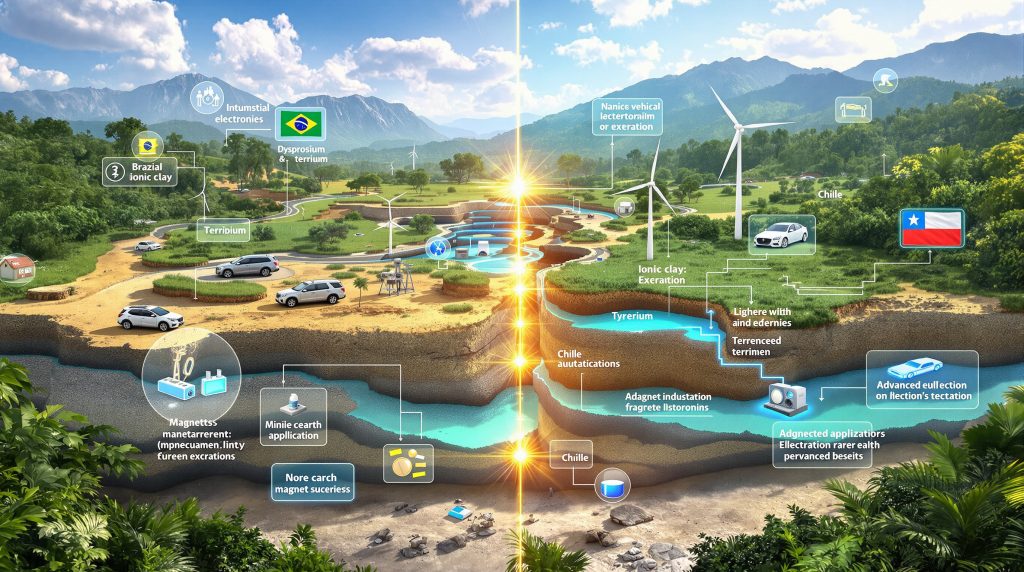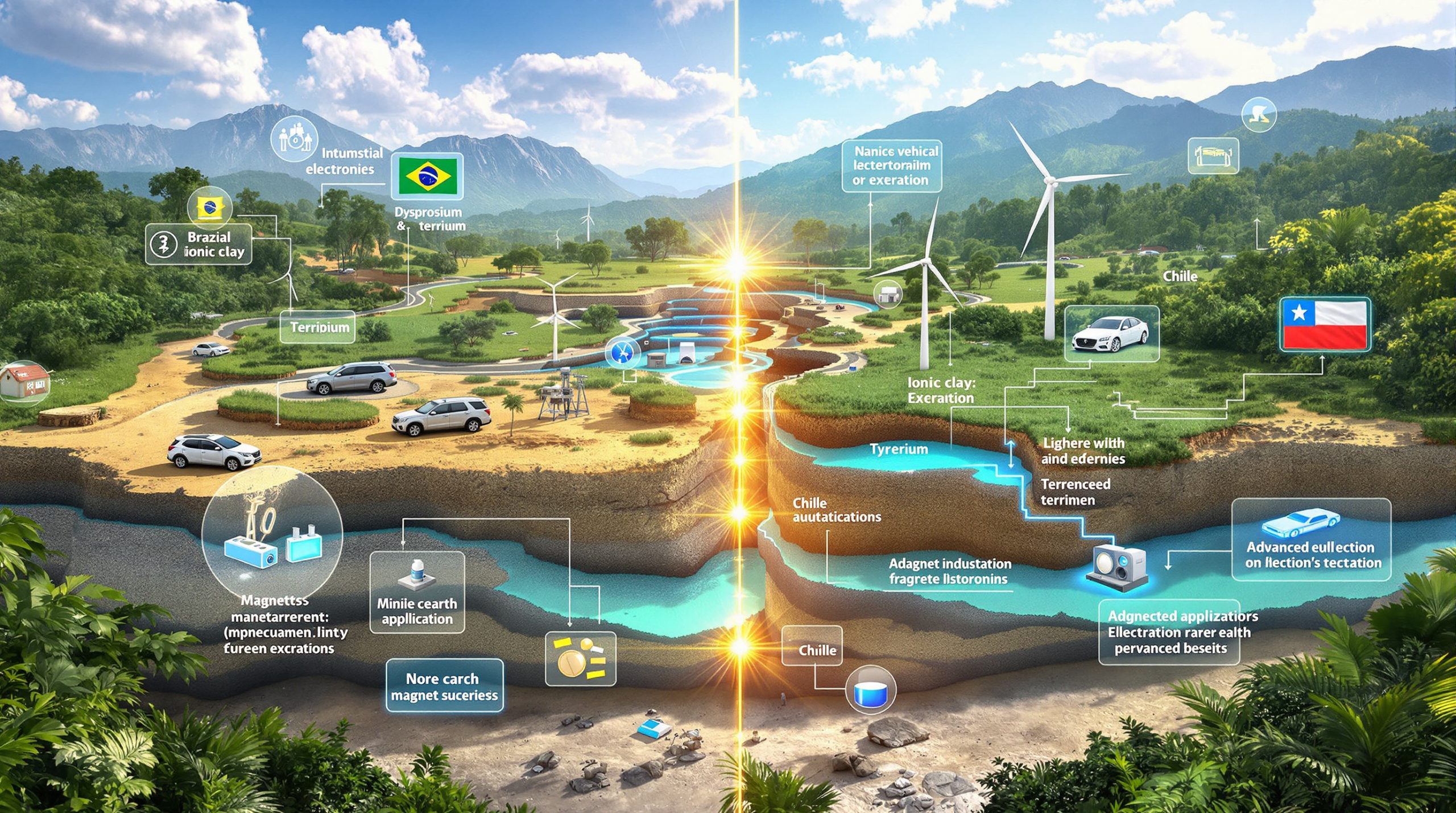Ionic Clay Rare Earth Deposits: Brazil and Chile's Strategic Resource
The discovery of ionic clay rare earth deposits in Brazil and Chile marks a significant shift in global rare earth element (REE) supply dynamics. These deposits represent a critical alternative to China's near-monopoly on heavy rare earth production, potentially reshaping global critical minerals energy security for these vital materials that power modern technology.
What Are Ionic Clay Rare Earth Deposits?
The Geological Distinction of Ionic Clay Deposits
Ionic clay deposits represent specialized geological formations where rare earth elements are weakly bonded to clay particles through ion-exchange mechanisms. Unlike traditional hard-rock deposits that require energy-intensive crushing and aggressive chemical processing, these unique formations allow for gentler extraction methods using mild leaching solutions.
These deposits form through extensive weathering processes of primary REE-bearing rocks in tropical and subtropical environments, creating ideal conditions for the accumulation of rare earth elements in an easily accessible form. The geological processes that create these formations require specific climatic and environmental conditions that make them exceptionally rare globally.
Why Ionic Clay Deposits Are Revolutionizing Rare Earth Mining
The extraction of rare earth elements from ionic clay deposits offers remarkable advantages over conventional hard-rock mining approaches, transforming the economics and environmental impact of rare earth production:
- Significantly reduced environmental footprint through simplified extraction methods
- Lower capital and operational costs with minimal crushing and grinding requirements
- Elimination of radioactive waste management issues typically associated with traditional REE mining
- Higher concentration of valuable heavy rare earth elements (HREEs)
- Compatibility with in-situ recovery methods that minimize surface disturbance
These advantages make ionic clay deposits particularly valuable in the transition toward more sustainable rare earth production models, addressing many of the environmental concerns that have plagued the industry.
The Global Scarcity of Ionic Clay Formations
Until recently, economically viable ionic clay deposits were primarily confined to southern China and parts of Southeast Asia, creating a natural geographic monopoly that reinforced China's dominance in heavy rare earth production. These deposits have been the principal source of dysprosium, terbium, and other critical heavy rare earths for decades.
The discovery of similar formations in Brazil and Chile represents a geological anomaly of significant strategic importance. Finding these scarce deposits in South America is described by industry experts as "not common," highlighting the exceptional nature of these resources. These discoveries could potentially break the geographic concentration of heavy rare earth supplies and diversify global production.
Why Are Heavy Rare Earths So Crucial for Modern Technology?
The Critical Role of Dysprosium and Terbium
Heavy rare earths, particularly dysprosium and terbium, serve an irreplaceable function in enhancing the temperature resistance of permanent magnets—a property critical for numerous high-performance applications.
Without these elements, permanent magnets demagnetize at temperatures above 60°C, rendering them impractical for many advanced applications. The addition of just 1-3% of dysprosium or terbium can dramatically increase their temperature stability to 150-240°C, enabling their use in high-temperature environments.
This temperature-stabilizing effect is not achievable with any other known elements, making heavy rare earths irreplaceable in current magnet technology. The small quantities required—just grams per device—belie their outsized importance in modern technological applications.
Applications Driving Heavy Rare Earth Demand
The increasing adoption of technologies dependent on high-performance magnets is driving unprecedented demand for heavy rare earths:
- Electric vehicle motors generate significant heat during operation, requiring temperature-stable magnets for reliable performance
- Wind turbine generators need magnets that maintain performance under continuous operation in variable conditions
- Defense systems rely on high-performance magnets for guidance systems, radar, and other mission-critical applications
- Industrial motors operating in demanding environments depend on temperature stability for longevity and efficiency
The clean energy transition is particularly dependent on these materials, with each electric vehicle requiring small but essential quantities of heavy rare earths to function efficiently. Similarly, the growth of renewable energy generation, particularly wind power, relies on these elements for optimal performance.
The Looming Supply-Demand Imbalance
Current market analysis reveals a concerning trajectory in heavy rare earth supply and demand:
- Present global demand stands at approximately 2,500 tons annually
- Projections indicate demand will reach 5,000 tons annually by 2030—a doubling of current requirements
- Production capacity outside China remains severely limited
- Recent implementation of Chinese export controls threatens to further constrain global supply
Industry experts express concern that even with accelerated development of known resources, supply may not keep pace with projected demand growth. This imbalance creates both strategic challenges for industries dependent on these materials and opportunities for new suppliers entering the market.
Brazil's Emerging Ionic Clay Resources
The Carina Project: Brazil's Flagship Rare Earth Development
Brazil's Carina project in Goiás state represents one of South America's most promising rare earth developments, containing what experts describe as a "copy paste" of the valuable Chinese deposits that have dominated global supply.
The project is advancing through critical development stages with a pre-feasibility study scheduled for completion in the immediate future. This study will establish the preliminary economic parameters for the project and provide insights into production potential and capital requirements.
Initial assessments indicate substantial concentrations of heavy rare earths critical for permanent magnet applications, particularly dysprosium and terbium. The project's development timeline targets initial production by 2028, aligned with the expected increase in global demand.
Development Timeline and Critical Milestones
The Carina project is progressing through several key development phases:
- Pre-feasibility study completion expected imminently
- Environmental assessment approval anticipated by early 2024
- Early infrastructure work commencement planned for 2024, including road improvements, camp facilities, and ancillary infrastructure
- Full feasibility study targeted for completion by Q1 2026
- Production commencement scheduled for 2028
This timeline reflects the typical 5-7 year development cycle for rare earth projects, balancing the urgency of bringing new supply online with the technical and regulatory requirements of establishing a new mining operation.
Environmental Permitting and Infrastructure Development
Environmental permitting represents a critical path item for the project's advancement:
- Environmental assessment currently under regulatory review
- Approval expected by late 2023 or early 2024
- Early works including road improvements planned to commence following permit approval
- Long-lead equipment ordering scheduled to accelerate the construction timeline
The permitting process has been facilitated by the project's environmentally advantageous extraction methods, which minimize many of the impacts associated with traditional mining. The use of ionic clay deposits enables simplified processing approaches that reduce environmental concerns typically associated with rare earth mining.
Chile's Strategic Rare Earth Potential
The Penco Module: Chile's Advanced Ionic Clay Project
Chile's rare earth development focuses on the Penco Module in the Bio-Bio region, representing another significant South American resource with strategic importance to global rare earth supply diversification.
The project emphasizes responsible development practices while advancing toward production on a timeline similar to the Brazilian project. The Chilean government's evolving perspective on critical minerals has created a more supportive regulatory environment for the project's development.
The deposit's characteristics enable environmentally responsible extraction methods, reducing many of the impacts typically associated with rare earth mining and positioning the project as an example of sustainable resource development.
Regulatory Evolution and Government Support
Chile's approach to rare earth development has undergone a significant transformation:
- Initial regulatory hesitancy toward rare earth mining has given way to recognition of their strategic importance
- Recent policy shifts acknowledge rare earths as critical minerals essential for clean energy transition
- Increased government support for sustainable development of strategic resources
- Permitting progress expected by year-end, reflecting improved regulatory alignment
This evolution mirrors global trends in recognizing the strategic importance of rare earth elements and the need for diversified supply chains. The Chilean government's changing perspective reflects broader recognition of rare earths' role in modern mine technology and clean energy systems.
Environmental Sustainability Approach
The Chilean project emphasizes environmental responsibility through several key approaches:
- Post-processing clay remediation and revegetation with native species to restore ecosystem function
- Implementation of water recirculation systems to minimize consumption in an often water-stressed region
- Reagent recycling processes to reduce chemical usage and minimize waste generation
- Elimination of traditional mining activities like drilling and blasting, reducing noise, dust, and overall environmental impact
These practices represent a significant departure from conventional rare earth mining methods, addressing many of the environmental concerns that have made rare earth mining controversial in other regions.
How Does Ionic Clay Processing Work?
The Extraction Technology Advantage
Ionic clay deposits enable simplified processing compared to traditional rare earth mining, representing a technological breakthrough in rare earth production:
- Utilization of in-situ recovery (ISR) or heap leaching with mild solutions rather than aggressive chemical processing
- Employment of environmentally preferable lixiviants such as magnesium sulfate or ammonium sulfate instead of harsh chemicals
- Ion-exchange process that selectively removes rare earths from clay while leaving most impurities behind
- Minimal physical disturbance of the deposit, reducing land impact and rehabilitation requirements
This technological approach dramatically reduces the environmental footprint of rare earth production while simultaneously lowering production costs—a rare win-win in resource development.
From Mine to Mixed Carbonate: The Initial Processing Stage
The first processing stage converts raw material to a mixed rare earth carbonate through several steps:
- Leaching of clay material with mild solutions to release ionically-bonded rare earth elements
- Precipitation of dissolved rare earth elements as mixed carbonates
- Production of a concentrate containing multiple rare earth elements in carbonate form
- Transportation of this intermediate product to separation facilities for further processing
This initial processing creates a stable, transportable product that contains the valuable rare earth elements in a form suitable for separation and refinement. The upcoming pilot plant at Virginia Tech University will validate this process at a larger scale, providing critical operational data and product samples for customer validation.
Separation and Refinement: Creating Pure Rare Earth Products
The separation process represents the most technically challenging aspect of rare earth production:
- Mixed carbonates require advanced separation technology to isolate individual rare earth elements
- Pilot testing at Virginia Tech University will validate laboratory-scale processes
- Full separation plant planned for U.S. location, with engineering work already initiated
- Production of individual rare earth oxides tailored to specific customer applications
This separation capability represents a critical link in establishing a complete supply chain outside China, addressing one of the most significant technical barriers to supply diversification.
The Vertical Integration Strategy
Why Control of the Entire Value Chain Matters
Vertical integration offers strategic advantages that address fundamental vulnerabilities in the rare earth sector:
- Reduced dependence on external suppliers for critical production stages
- Quality control throughout the production process ensures consistent product specifications
- Ability to tailor products to specific end-user requirements, creating premium value opportunities
- Protection against market volatility and geopolitical mining landscape disruptions through supply chain control
This integrated approach contrasts with many previous Western attempts to establish rare earth production, which often focused on mining without addressing the critical midstream processing steps.
From Mine to Magnet: The Complete Production Pathway
The full vertical integration strategy encompasses multiple stages in a coordinated development approach:
- Mining and initial processing in Brazil and Chile to produce mixed rare earth carbonates
- Separation and refinement in the United States to create individual rare earth oxides
- Metallization and alloy production to convert oxides into metals and alloys
- Partnership with established magnet manufacturers like Vacuum Schmelze (Germany) to complete the supply chain
- Direct supply relationships with end-users in critical industries to ensure market alignment
This comprehensive approach addresses the entire value chain, creating a resilient supply system that reduces vulnerability to disruptions at any single point.
The Metallization and Alloy Production Phase
The final processing stages convert oxides to metals and alloys suitable for magnet manufacturing:
- Pre-feasibility study for metallization plant expected by year-end, establishing economic parameters
- Demonstration plant planned for next year to validate processes at scale
- Production of metals and alloys meeting precise specifications for magnet manufacturing
- Direct supply relationships with magnet producers to complete the value chain
This capability represents a critical step often overlooked in rare earth development projects, addressing one of the key bottlenecks in establishing complete supply chains outside China.
How Do Geopolitical Factors Impact Rare Earth Development?
China's Historical Dominance and Strategic Positioning
China's approach to rare earth production has fundamentally shaped global markets and supply chain development:
- Long-term strategy of establishing low-cost magnet production to capture downstream value
- Development of complete mine-to-magnet supply chains creating integrated production advantages
- Previous export restrictions in 2010 causing significant market disruption and price volatility
- Recent implementation of new export controls on critical materials raising concerns about future supply security
This strategic approach has created both market advantages for Chinese producers and vulnerabilities for industries dependent on these materials, driving recent efforts to diversify supply.
Western Government Responses and Support Mechanisms
Western nations are implementing various support mechanisms to accelerate rare earth development:
- Provision of subsidized debt financing to reduce capital costs and accelerate project development
- Direct investment in critical mineral development through sovereign wealth funds and development agencies
- Implementation of floor price guarantees to reduce market risk for producers
- Allocation of research funding for processing technology development to overcome technical barriers
These mechanisms reflect recognition of both the strategic importance of rare earth elements and the market challenges of establishing new production in competition with established suppliers.
The Race to Secure Supply: Are Current Efforts Sufficient?
Despite increasing support, significant concerns remain about the pace and scale of new rare earth development:
- Current projects in development may not meet projected demand growth, creating potential supply shortfalls
- Typical 5-10 year development timeline for new projects creates lag between investment and production
- Need for additional resource identification and development beyond currently known deposits
- Continued dependence on Chinese supply in the near term while new projects advance toward production
These concerns highlight the strategic importance of accelerating development of alternative supply sources like the South American ionic clay deposits.
What Makes South American Ionic Clay Deposits Globally Significant?
The Rarity Factor: Why These Discoveries Matter
The South American discoveries represent a significant shift in global rare earth geography with strategic implications:
- Previously, economically viable ionic clay deposits were primarily limited to southern China and parts of Southeast Asia
- Brazilian deposits described as a "copy paste" of Chinese deposits, suggesting comparable quality and extraction potential
- Chilean resources provide additional diversification of heavy rare earth supplies
- Strategic location in politically stable, mining-friendly jurisdictions enhances supply security
The geological similarity to productive Chinese deposits suggests these resources could be developed using proven extraction and processing methods, reducing technical risk.
Comparative Advantages Over Other Deposit Types
Ionic clay deposits offer several advantages compared to other rare earth sources that enhance their strategic value:
- Lower capital expenditure requirements than hard-rock mining, reducing financial barriers to development
- Reduced operating costs due to simplified processing, enhancing economic sustainability
- Minimal radioactive waste management issues that often complicate hard-rock rare earth mining
- Higher concentration of valuable heavy rare earths creates favorable economics
- Smaller environmental footprint reduces regulatory and social license challenges
These advantages make ionic clay deposits particularly attractive for development in the current market environment, where both economic and environmental considerations influence project advancement.
Production Potential and Global Market Impact
The development of South American deposits could significantly impact global supply dynamics:
- Potential to supply a substantial portion of Western heavy rare earth demand, reducing dependence on Chinese sources
- Diversification of supply away from Chinese dominance, enhancing supply security for critical industries
- Price stabilization through increased competition and supply diversification
- Enhanced supply security for critical industries including automotive, renewable energy, and defense sectors
The strategic timing of these developments, coinciding with rapidly increasing demand for heavy rare earths, amplifies their global significance.
Environmental Considerations in Ionic Clay Mining
Sustainable Mining Approaches
Ionic clay projects emphasize environmental responsibility through several innovative approaches:
- Implementation of in-situ recovery methods that minimize surface disturbance and reduce the mining footprint
- Application of heap leaching techniques that avoid traditional mining impacts like blasting and excavation
- Utilization of recirculation systems for processing solutions to reduce water consumption and prevent discharge
- Development of progressive remediation and revegetation processes for processed areas
These approaches represent a significant advancement over conventional rare earth mining methods, addressing many of the environmental concerns that have made rare earth production controversial.
Water Management and Conservation
Water management represents a critical aspect of sustainable development in rare earth mining:
- Design and implementation of closed-loop systems that recycle processing water, minimizing consumption
- Significant reduction in freshwater requirements compared to conventional mining through efficient water use
- Development of comprehensive monitoring programs to protect groundwater resources from potential impacts
- Adaptation of processing methods to local hydrological conditions to ensure sustainability
These water conservation approaches are particularly important in regions with variable water availability, ensuring operations remain sustainable during dry periods.
Post-Mining Land Restoration
Land restoration plans include comprehensive approaches to ecosystem recovery:
- Implementation of progressive rehabilitation during operations rather than deferring to mine closure
- Development of revegetation programs using native species to restore ecosystem function
- Application of soil management techniques to support long-term ecosystem recovery
- Establishment of long-term monitoring programs to track environmental parameters and ensure restoration success
These restoration approaches aim to leave post-mining landscapes in a condition that supports ecosystem function and sustainable land use. Furthermore, advancements in mine reclamation innovation have provided new techniques for restoring landscapes affected by mining activities.
The Future of Rare Earth Supply Chains
Projected Timeline for South American Production
The development timeline indicates a coordinated approach to bringing new supply online:
- Brazilian production targeted for 2028, aligning with projected demand increases
- Chilean production advancing on a similar timeline, creating potential for coordinated market entry
- Separation and refining capacity development progressing in parallel to ensure processing capability
- Full vertical integration expected by 2030, creating complete supply chains outside China
This timeline reflects both the technical requirements of developing new projects and the strategic imperative of bringing new supply online to meet projected demand growth.
Integration with Global Manufacturing Networks
The strategic plan includes development of comprehensive supply relationships:
- Establishment of direct supply relationships with magnet manufacturers, including partnership with German firm Vacuum Schmelze
- Development of strategic partnerships with automotive and renewable energy companies to align production with end-user needs
- Creation of regional supply chains in the Americas to reduce logistical vulnerabilities
- Reduction in reliance on trans-Pacific shipping, decreasing transportation costs and carbon footprint
These integration efforts aim to create resilient supply chains that connect raw material production directly to manufacturing and end-use applications.
The Technology Transformation: From Mining Company to Materials Provider
The evolution from traditional mining to technology-focused materials production involves several key transitions:
- Development of proprietary processing technologies that create competitive advantages
- Establishment of advanced separation and refinement capabilities that enhance product value
- Production of specialized materials tailored to specific high-tech applications
- Creation of research partnerships with universities and technology companies to drive innovation
This transformation reflects the increasing importance of technical capabilities in creating value from rare earth resources, moving beyond simple extraction to sophisticated materials production.
FAQ: Ionic Clay Rare Earth Deposits
What makes ionic clay deposits different from traditional rare earth mines?
Ionic clay deposits contain rare earth elements that are weakly bonded to clay particles through ion-exchange mechanisms. This unique formation allows for extraction using mild leaching solutions rather than the intensive crushing, grinding, and aggressive chemical processing required for hard-rock deposits. The deposits typically contain higher concentrations of valuable heavy rare earths and can be processed with significantly lower environmental impact, reduced energy consumption, and simpler processing requirements.
Why are heavy rare earths like dysprosium and terbium so valuable?
Heavy rare earths like dysprosium and terbium are essential for enhancing the temperature resistance of permanent magnets. Without these elements, magnets demagnetize at temperatures above 60°C, making them unsuitable for applications like electric vehicle motors and wind turbines. Adding just 1-3% of these elements increases temperature stability to 150-240°C, enabling high-performance applications. Their limited global supply, concentrated primarily in China, combined with growing demand from clean energy technologies makes them particularly valuable and strategically important.
How do in-situ recovery methods work for rare earth extraction?
In-situ recovery involves injecting mild leaching solutions (like magnesium sulfate) directly into the deposit, where they dissolve the ionically-bonded rare earth elements through an ion-exchange process. The solution containing dissolved rare earths is then pumped to the surface for processing, with minimal disturbance to the surrounding environment. This method eliminates the need for traditional mining activities like drilling, blasting, and excavation, significantly reducing the environmental footprint of rare earth production.
What is the timeline for South American rare earth production?
Current development plans target initial production from both Brazilian and Chilean deposits by 2028. This timeline includes completing pre-feasibility studies imminently, securing environmental permits by early 2024, commencing early infrastructure work in 2024, completing full feasibility studies by 2026, and constructing production facilities between 2026 and 2028. Separation and refining capacity is being developed in parallel, with pilot testing at Virginia Tech University beginning shortly and full-scale facilities planned to align with mining production.
How might these new deposits affect global rare earth markets?
The development of South American ionic clay deposits could significantly diversify global heavy rare earth supply, currently dominated by China. This diversification may lead to more stable pricing, enhanced supply security for Western manufacturers, and reduced geopolitical leverage. The deposits' location in mining-friendly jurisdictions with established regulatory frameworks provides advantages for development, while their geological characteristics enable environmentally responsible extraction methods that address many concerns associated with traditional rare earth mining.
The Strategic Importance of South American Rare Earth Development
The discovery and development of ionic clay rare earth deposits in Brazil and Chile represent a transformative opportunity to diversify global supply chains for critical heavy rare earth elements. With their environmental advantages, high concentration of valuable elements, and strategic location, these deposits could play a pivotal role in supporting the transition to clean energy technologies and advanced manufacturing.
As these projects progress toward production, they face challenges including regulatory approvals, technical development, and market competition. However, their potential to provide a secure, environmentally responsible source of heavy rare earths positions them as strategically important resources in the evolving global rare earth landscape.
The vertical integration strategy being pursued—from mining through separation, metallization, and alloy production—offers a comprehensive approach to addressing supply chain vulnerabilities. By controlling the entire value chain, developers aim to create resilient supply networks capable of supporting critical industries through the clean energy transition and beyond, reducing dependency on geographically concentrated supply sources.
The success of these developments will depend not only on technical execution but also on continued government support, strategic partnerships, and mining waste management innovations. With global demand for heavy rare earths projected to double by 2030, the timing of these projects aligns with a critical period in the transition toward a more diversified and sustainable rare earth supply chain.
Disclaimer: This article contains forward-looking statements regarding mineral resources, project development timelines, and market projections. Readers should be aware that resource development is subject to technical, regulatory, and market uncertainties that may affect outcomes and timelines.
Are You Tracking Australian Critical Mineral Discoveries?
Discover the next major rare earth deposit before the market with Discovery Alert's proprietary Discovery IQ model, delivering instant notifications on significant ASX mineral discoveries. Visit the Discovery Alert discoveries page to understand how historic discoveries like ionic clay rare earths can generate substantial returns for early investors.




